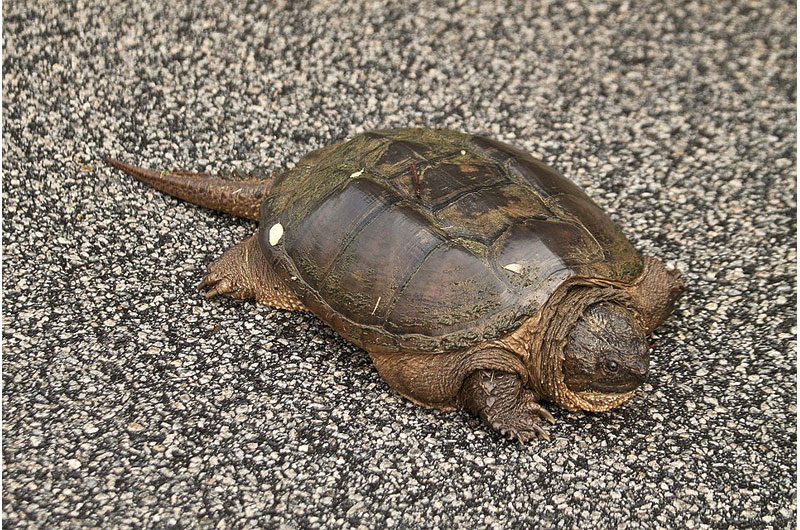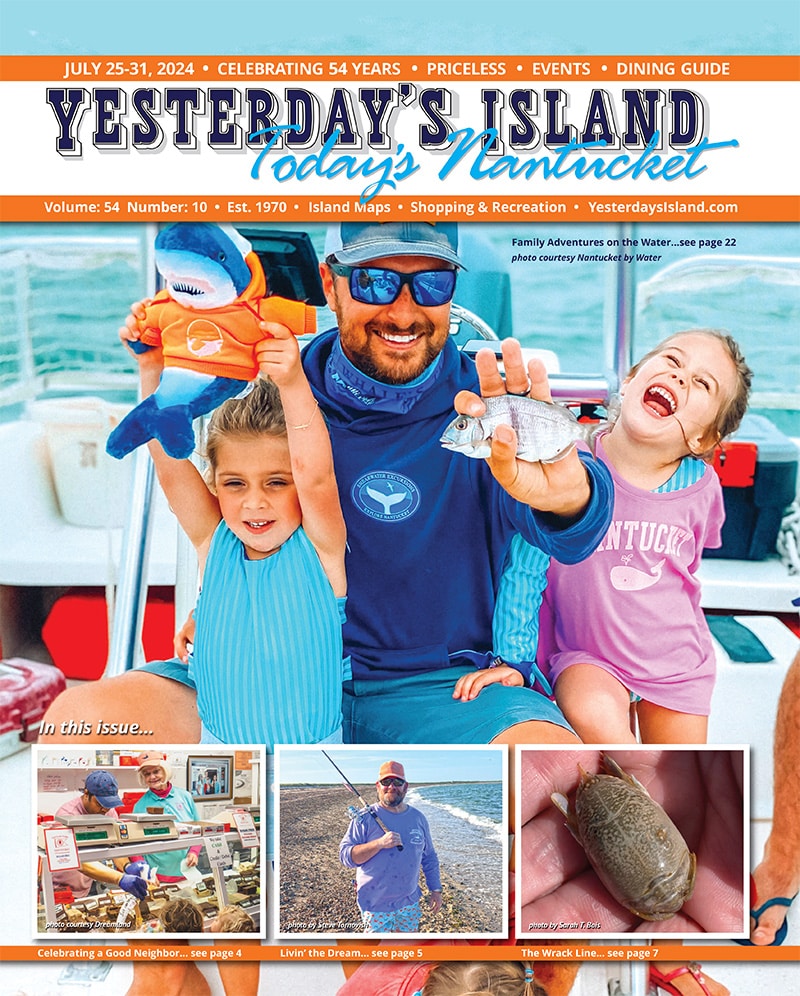by Dr. Sarah Treanor Bois, PhD
Director of Research & Education at the Linda Loring Nature Foundation
Did you know that the ancestors of our Nantucket snapping turtles existed more than 40 million years ago?! These prehistoric-looking creatures are top predators in many aquatic systems and an important part of the present-day Nantucket ecosystem. Unfortunately, we may be “loving” them a little too much. Feeding practices, turtle handling, and otherwise harassing these wild animals has reached a fever pitch the past few years and local conservation and wildlife groups are hoping to do something about it.
Snapping turtles are truly amazing creatures. The common snapping turtle (Chelydra serpentina) can be found from southeastern Canada to the southern tip of the Florida panhandle. Almost any freshwater or somewhat brackish pond will have snapping turtles and many people living or visiting Nantucket can likely tell you that Long Pond is the “best” place to see them. The long, t-shape dock along Madaket Road is often a hot-bed of turtle feeding activity in the summer months: a practice that many are finding more and more unethical.
There is a new effort on-island to end the problematic and illegal practice of feeding snapping turtles. While rumblings of this have been going on for some time, in the past year a group of scientists, educators, and wildlife advocacy groups came together to discuss the practice. This Snapping Turtle Coalition, unofficially known as “Team Turtle,” includes the Nantucket Conservation Foundation, the Linda Loring Nature Foundation, Nantucket Island Safe Harbor for Animals, the Maria Mitchell Association, Town of Nantucket Natural Resources Department, and the Nantucket Island Land Bank.
The group has initiated a multi-pronged approach to educating the public about Nantucket snapping turtle ecology and the dangers of feeding them. The first step is outreach and education. Letters were sent to all the summer camps on the island hoping to discourage feeding of turtles with an overall goal of encouraging appreciation without the need for contact.
The group has also worked on a new sign that will be soon installed at First and Second Bridges along Madaket Road. The sign, presented in English and Spanish, has information about the dangers of feeding snapping turtles and a link to an educational resource page. The page has news articles and facts about snapping turtles, and it will be supplemented with educational additional materials.
From the letter to Nantucket camps:
“We know that for some, there is a tradition of feeding the turtles every summer… We also know that this can present dangers to snapping turtles. So, we have worked on signage which features information about our snapping turtles which we hope will discourage feeding and handling of turtles while encouraging respect of our island wildlife.” So, why is it so bad to feed the turtles? Biologically, here are some of the primary reasons:
- Snapping turtles are usually nocturnal. Habituating them to daytime feeding wreaks havoc with their normal sleep patterns.
- Snapping turtles are territorial. Feeding keeps them in larger numbers in a smaller area than is otherwise natural. This can lead to disease transmission and other issues seen with wildlife crowding.
- Snapping turtles habituated to people will pursue people for food. This can lead to turtles seeming more aggressive to people who aren’t feeding them. It can also lead to more turtle deaths as they look for food crossing the road.
- When the summer ends, and so does the daily feeding, the turtles will have to adjust to their natural rhythms and feeding behavior. This can cause a decline in the population as turtles fight for the remaining resources.
Snapping turtles don’t need any help getting food. A common native species, they aren’t starving or in particular need. They are important aquatic scavengers and omnivores. Snapping turtles are also active hunters that use ambush tactics to prey on anything they can swallow, including many invertebrates, fish, frogs, reptiles (including snakes and smaller turtles), unwary birds, and sometimes small mammals. They will also feed on carrion and a surprisingly large amount of aquatic vegetation.
Snapping turtles have a strong sense of smell, vision, or touch that helps them find and identify their prey while on land, and they can also sense vibrations in the water. You may have noticed this if you’ve ever walked out on the dock at First Bridge. Just walking out onto the dock brings out dozens of snapping turtles.
Snapping turtles are among the nonsocial creatures that are solitary and prefer not to associate or live with other turtles in the wild. Even though many turtles would be found living in a particular area, they prefer living alone. Their social interactions are limited to displaying aggression among them.
In addition, it has never made sense to me that people use raw chicken to feed the turtles. It is unsanitary to have children handling raw chicken on a hot summer day. With worry about water quality on Long Pond, I can’t imagine that hundreds of pounds of raw chicken every summer really helps the situation. There is also the issue of garbage left at the site. Working nearby, I regularly visit the area. There is almost always some kind of trash from the feeding practice— chicken bones, packaging, and the worst of all, fishing line.
Fishing line has been one of the biggest issues lately. String or twine can be easily broken. But 50-100 lb test fishing line is meant to reel in large ocean fish. These lines are getting tangled around turtles and can be a hazard to other wildlife, namely birds like osprey who feed out of the pond. Fishing line doesn’t degrade easily and can last in the environment up to 600-800 years!
In addition to ending the feeding practice, the goal of the Snapping Turtle Coalition is to educate the public about the wonders of snapping turtles. Many children have been in awe of snapping turtles because of seeing them on Long Pond. We’d love for them to learn to appreciate the turtles without the harassment of feeding them.
“When children are taught to recognize the specific behaviors of animals, they’re better prepared to respect them…Unfortunately, this (feeding) practice is nothing like the turtle’s natural behavior. At NiSHA, we teach children about empathy because it’s important to attempt to understand the feelings of others and when kids respect animals, they also then respect other people. Just like the old saying goes, ‘When you know better, you can do better.’ ” – Jillian Lucchini a, wildlife rehabber and NiSHA representative.
In healthy aquatic ecosystems, snapping turtles make up 10 times as much biomass as most mammal and bird species. Their abundance benefits ecosystems in several ways: turtle eggs are a highly nutritious food that mammals and birds can feed to their young; turtles clean waterways by consuming dead and decaying fish and other animals; and turtles create channels that fish, amphibians and smaller reptiles use to move efficiently through a muddy wetland.
One way you can learn more about and appreciate these amazing creatures up close is through various programs around the island. The Maria Mitchell Association often has a snapping turtle in their live animal room at the Natural Science Museum at 7 Milk St. Currently they have painted turtles and red-eared sliders for up close connections to other turtle species.
“As a humane education teacher who works with children of all ages, I’ve seen firsthand how much they care about animals and feel sure that if they really knew the harm caused to the island’s snapping turtles by feeding them, they would want to stop immediately!” said Susan Richards, NiSHA Humane Education Coordinator.
Help keep our snapping turtles wild and healthy. Enjoy them from afar with your eyes. The species may yet survive another 40 million years!
*Sign installation and an official ribbon cutting ceremony is TBA and will be announced when details are known.



